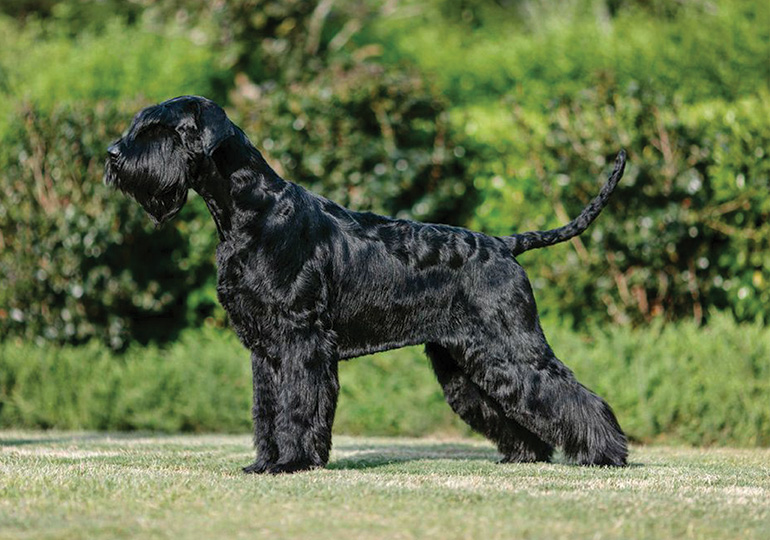Schnauzer (Giant)
Breed Details
Size:
Exercise Requirements:
Grooming Requirements:
25-38 Kg (Approx)
12-15 years (Approx)

Appearance
The wonderful world of choice is relevant to Schnauzers. Just like coffee, they come in small, medium and extra-large.
There are three distinct and different breeds falling under the category of Schnauzers: the Miniature (small), Standard (medium) and Giant (extra-large). From the original “standard size” the Miniature and Giant Schnauzers were developed. The aim was to produce exact replicas of the (Standard) Schnauzer in appearance and temperament but in smaller and larger sizes, that is, a sturdy, sensibly built and useful dog of great intelligence and reliability, loyal to its family but wary of strangers.
Sturdily built, robust, sinewy, nearly square, (length of body equal to height at shoulders). Expression Is keen and attitude alert. The Giant is also described as powerfully built and imposing.
The name Schnauzer refers to their distinctive facial appearance. Beards and eyebrows are a feature of all three breeds. The Schnauzer expression is characterised by an alert, “down the nose” expression enhanced by the correctly set ear, dark eye, dark facial mask in the salt and pepper and black and silver and their leg furnishings. They have a harsh outer coat and soft undercoat. They do not shed their coats and require regular stripping for the show ring so they can be presented with an outer wiry, coarse coat against a short undercoat. Clipping of the coat is usual for dogs that are not shown.
Eyes are medium sized, dark, oval, set forward with arched, bushy eyebrows. Ears: neat v-shaped, set high and dropping forward to temple.
All sizes are nearly square in profile (length of body being equal to height at the shoulders). Ideal height for all the Schnauzer (Giant) is as follows: Dogs 65-70cm, Bitches: 60-65cm. (any variations of more than 2.5cms in these heights is undesirable.
The most common colour is pepper and salt, across all three breeds, with black also represented across all three.
History
The Schnauzer originated in the 1400s in the regions of Bavaria and Wurttenberg in southern Germany in central Europe. It was developed from the crossing of German Poodle, Grey Wolf Spitz and Wire Haired Terrier (German Pinscher), primarily as a ratter, a droving and herding breed with watchdog capabilities.
It is believed the Miniature was developed by crossing smaller Standard Schnauzers with Affenpinschers and the Giant by crossing the larger Standard Schnauzers with the Great Dane and possibly the Bouvier des Flandres, or with large, coarse coated dogs known as Bavarian Wolfhounds. The Miniature’s primary purpose was to hunt vermin and as companions within the home.
The Giant was bred to drive cattle to market, which in turn saw their guarding ability come to the fore, with them being incorporated into guarding duties for butcher shops, breweries and prisons. These days their skills have been identified and used heavily in Search and Rescue, as well as police and protection work overseas.
Temperament
Schnauzer (Giant) temperament is bold, reliable, good natured and composed.
This is a dog with the characteristics of a working dog. Bred originally as guard/watch dogs, ratters and as droving dogs, they should not be shy, retiring or act afraid. They are alert and intelligent, and while they will not start a fight, they will not back down. Their guard/ watch dog character make them wary of strangers.
The three breeds are seen as companion dogs and all three breeds do well at Obedience, Agility and Rally events.
Care/Grooming
The Giant Schnauzer has a dense, wiry, weather-resistant double coat consisting of a soft undercoat and a harsh outer coat. The Giant must be brushed weekly, and clipped or stripped regularly to maintain a healthy and attractive coat. The owner should be prepared to spend time maintaining the coat or plan to have the dog periodically groomed by the breeder or someone whom the breeder recommends.
Breeders
Currently no Breeders in SA for this Breed

